Warfarin Sodium
WARFARIN SODIUM TABLETS, USP
FULL PRESCRIBING INFORMATION: CONTENTS*
- WARFARIN SODIUM DESCRIPTION
- CLINICAL PHARMACOLOGY
- CLINICAL TRIALS
- WARFARIN SODIUM INDICATIONS AND USAGE
- WARFARIN SODIUM CONTRAINDICATIONS
- WARNINGS
- PRECAUTIONS
- WARFARIN SODIUM ADVERSE REACTIONS
- OVERDOSAGE
- WARFARIN SODIUM DOSAGE AND ADMINISTRATION
- Venous Thromboembolism (including deep venous thrombosis [DVT] and pulmonary embolism [PE])
- Atrial Fibrillation
- Post-Myocardial Infarction
- Mechanical and Bioprosthetic Heart Valves
- Recurrent Systemic Embolism and Other Indications
- Initial Dosage
- Maintenance
- Duration of Therapy
- Missed Dose
- Laboratory Control
- Treatment During Dentistry and Surgery
- Conversion From Heparin Therapy
- HOW SUPPLIED
- REFERENCES
- MEDICATION GUIDE
- PRINCIPAL DISPLAY PANEL - 1 mg Blister
- PRINCIPAL DISPLAY PANEL - 1 mg Carton
- PRINCIPAL DISPLAY PANEL - 2 mg Blister
- PRINCIPAL DISPLAY PANEL - 2 mg Carton
- PRINCIPAL DISPLAY PANEL - 2.5 mg Blister
- PRINCIPAL DISPLAY PANEL - 2.5 mg Carton
- PRINCIPAL DISPLAY PANEL - 3 mg Blister
- PRINCIPAL DISPLAY PANEL - 3 mg Carton
- PRINCIPAL DISPLAY PANEL - 4 mg Blister
- PRINCIPAL DISPLAY PANEL - 4 mg Carton
- PRINCIPAL DISPLAY PANEL - 5 mg Blister
- PRINCIPAL DISPLAY PANEL - 5 mg Carton
- PRINCIPAL DISPLAY PANEL - 6 mg Blister
- PRINCIPAL DISPLAY PANEL - 6 mg Carton
FULL PRESCRIBING INFORMATION
Rx only
WARNING: BLEEDING RISK
Warfarin sodium can cause major or fatal bleeding. Bleeding is more likely to occur during the starting period and with a higher dose (resulting in a higher INR). Risk factors for bleeding include high intensity of anticoagulation (INR >4.0), age ≥65, highly variable INRs, history of gastrointestinal bleeding, hypertension, cerebrovascular disease, serious heart disease, anemia, malignancy, trauma, renal insufficiency, concomitant drugs (see PRECAUTIONS), and long duration of warfarin therapy. Regular monitoring of INR should be performed on all treated patients. Those at high risk of bleeding may benefit from more frequent INR monitoring, careful dose adjustment to desired INR, and a shorter duration of therapy. Patients should be instructed about prevention measures to minimize risk of bleeding and to report immediately to physicians signs and symptoms of bleeding (see PRECAUTIONS, Information for Patients).
WARFARIN SODIUM DESCRIPTION
Warfarin sodium is an anticoagulant which acts by inhibiting vitamin K-dependent coagulation factors. Chemically, it is 3-(α-acetonylbenzyl)-4-hydroxycoumarin and is a racemic mixture of the R- and S- enantiomers. Warfarin sodium is an isopropanol clathrate. The crystallization of warfarin sodium virtually eliminates trace impurities present in amorphous warfarin. Its structural formula may be represented as follows:
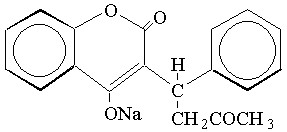
Warfarin sodium occurs as a white, odorless, crystalline powder, is discolored by light and is very soluble in water; freely soluble in alcohol; very slightly soluble in chloroform and in ether.
Each tablet, for oral administration, contains 1 mg, 2 mg, 21/2 mg, 3 mg, 4 mg, 5 mg, 6 mg, 71/2 mg or 10 mg warfarin sodium. In addition, each tablet contains the following inactive ingredients: anhydrous lactose, hypromellose 2208 (3cPs), magnesium stearate, and pregelatinized starch.
The 1 mg also contains D&C red no. 6 barium lake.
The 2 mg also contains FD&C blue no. 2 aluminum lake, and FD&C red no. 40 aluminum lake.
The 21/2 mg also contains D&C yellow no. 10 aluminum lake, and FD&C blue no. 1 aluminum lake.
The 3 mg also contains FD&C blue no. 2 aluminum lake, FD&C red no. 40 aluminum lake, and FD&C yellow no. 6 aluminum lake.
The 4 mg also contains FD&C blue no. 1 aluminum lake.
The 5 mg also contains FD&C yellow no. 6 aluminum lake.
The 6 mg also contains FD&C blue no. 1 aluminum lake, and FD&C yellow no. 6 aluminum lake.
The 71/2 mg also contains D&C yellow no. 10 aluminum lake, and FD&C yellow no. 6 aluminum lake.
The 10 mg does not contain any dyes.
CLINICAL PHARMACOLOGY
Warfarin sodium and other coumarin anticoagulants act by inhibiting the synthesis of vitamin K dependent clotting factors, which include Factors II, VII, IX, and X, and the anticoagulant proteins C and S. Half-lives of these clotting factors are as follows: Factor II - 60 hours, VII - 4 to 6 hours, IX - 24 hours, and X - 48 to 72 hours. The half-lives of proteins C and S are approximately 8 hours and 30 hours, respectively. The resultant in vivo effect is a sequential depression of Factor VII, Protein C, Factor IX, Protein S, and Factor X and II activities. Vitamin K is an essential cofactor for the post ribosomal synthesis of the vitamin K dependent clotting factors. The vitamin promotes the biosynthesis of γ-carboxyglutamic acid residues in the proteins which are essential for biological activity.
Mechanism of Action
Warfarin is thought to interfere with clotting factor synthesis by inhibition of the C1 subunit of the vitamin K epoxide reductase (VKORC1) enzyme complex, thereby reducing the regeneration of vitamin K1 epoxide. The degree of depression is dependent upon the dosage administered and, in part, by the patient’s VKORC1 genotype. Therapeutic doses of warfarin decrease the total amount of the active form of each vitamin K dependent clotting factor made by the liver by approximately 30% to 50%.
An anticoagulation effect generally occurs within 24 hours after drug administration. However, peak anticoagulant effect may be delayed 72 to 96 hours. The duration of action of a single dose of racemic warfarin is 2 to 5 days. The effects of warfarin sodium may become more pronounced as effects of daily maintenance doses overlap. Anticoagulants have no direct effect on an established thrombus, nor do they reverse ischemic tissue damage. However, once a thrombus has occurred, the goal of anticoagulant treatment is to prevent further extension of the formed clot and prevent secondary thromboembolic complications, which may result in serious and possibly fatal sequelae.
Pharmacokinetics
Warfarin sodium is a racemic mixture of the R- and S-enantiomers. The S-enantiomer exhibits 2 to 5 times more anticoagulant activity than the R-enantiomer in humans, but generally has a more rapid clearance.
Absorption
Warfarin sodium is essentially completely absorbed after oral administration with peak concentration generally attained within the first 4 hours.
Distribution
There are no differences in the apparent volumes of distribution after intravenous and oral administration of single doses of warfarin solution. Warfarin distributes into a relatively small apparent volume of distribution of about 0.14 liter/kg. A distribution phase lasting 6 to 12 hours is distinguishable after rapid intravenous or oral administration of an aqueous solution. Using a one compartment model, and assuming complete bioavailability, estimates of the volumes of distribution of R- and S-warfarin are similar to each other and to that of the racemate. Concentrations in fetal plasma approach the maternal values, but warfarin has not been found in human milk (see WARNINGS, Lactation). Approximately 99% of the drug is bound to plasma proteins.
Metabolism
The elimination of warfarin is almost entirely by metabolism. Warfarin sodium is stereoselectively metabolized by hepatic microsomal enzymes (cytochrome P-450) to inactive hydroxylated metabolites (predominant route) and by reductases to reduced metabolites (warfarin alcohols). The warfarin alcohols have minimal anticoagulant activity. The metabolites are principally excreted into the urine; and to a lesser extent into the bile. The metabolites of warfarin that have been identified include dehydrowarfarin, two diastereoisomer alcohols, 4'-, 6-, 7-, 8- and 10-hydroxywarfarin. The cytochrome P-450 isozymes involved in the metabolism of warfarin include 2C9, 2C19, 2C8, 2C18, 1A2, and 3A4. 2C9 is likely to be the principal form of human liver P-450 which modulates the in vivo anticoagulant activity of warfarin.
The S-enantiomer of warfarin is mainly metabolized to 7-hydroxywarfarin by CYP2C9, a polymorphic enzyme. The variant alleles of CYP2C9*2 and CYP2C9*3 result in decreased in vitro CYP2C9 enzymatic 7-hydroxylation of S-warfarin. The frequencies of these allelles in Caucasians are approximately 11% and 7% for CYP2C9*2 and CYP2C9*3, respectively1. Patients with one or more of these variant CYP2C9 alleles have decreased S-warfarin clearance (Table 1).2
| CYP2C9 Genotype | N |
S-Warfarin Clearance/Lean Body Weight (mL/min/kg) Mean (SD) |
| *1/*1 | 118 | 0.065 (0.025) |
| *1/*2 or *1/*3 | 59 | 0.041 (0.021) |
| *2/*2, *2/*3, or *3/*3 | 11 | 0.020 (0.011) |
| Total | 188 |
Other CYP2C9 alleles associated with reduced enzymatic activity occur at lower frequencies, including *5, *6, and *11 alleles in populations of African ancestry and *5, *9, and *11 alleles in Caucasians.
Pharmacogenomics
A meta-analysis of 9 qualified studies including 2775 patients (99% Caucasian) was performed to examine the critical outcomes associated with CYP2C9 gene variants in warfarin-treated patients.3 In this meta-analysis, 3 studies assessed bleeding risks and 8 studies assessed daily dose requirements. The analysis suggested an increased bleeding risk for patients carrying either the CYP2C9*2 or CYP2C9*3 alleles. Patients carrying at least one copy of the CYP2C9*2 allele required a mean daily warfarin dose that was 17% less than the mean daily dose for patients homozygous for the CYP2C9*1 allele. For patients carrying at least one copy of the CYP2C9*3 allele, the mean daily warfarin dose was 37% less than the mean daily dose for patients homozygous for the CYP2C9*1 allele.
In an observational study, the risk of achieving INR >3 during the first 3 weeks of warfarin therapy was determined in 219 Swedish patients retrospectively grouped by CYP2C9 genotype.
The relative risk of over anticoagulation as measured by INR >3 during the first 2 weeks of therapy was approximately doubled for those patients classified as *2 or *3 compared to patients who were homozygous for the *1 allele.4
Warfarin reduces the regeneration of vitamin K from vitamin K epoxide in the vitamin K cycle, through inhibition of vitamin K epoxide reductase (VKOR), a multiprotein enzyme complex. Certain single nucleotide polymorphisms in the VKORC1 gene (especially the -1639G>A allele) have been associated with lower dose requirements for warfarin. In 201 Caucasian patients treated with stable warfarin doses, genetic variations in the VKORC1 gene were associated with lower warfarin doses. In this study, about 30% of the variance in warfarin dose could be attributed to variations in the VKORC1 gene alone; about 40% of the variance in warfarin dose could be attributed to variations in VKORC1 and CYP2C9 genes combined.5 About 55% of the variability in warfarin dose could be explained by the combination of VKORC1 and CYP2C9 genotypes, age, height, body weight, interacting drugs, and indication for warfarin therapy in Caucasian patients.5 Similar observations have been reported in Asian patients.6,7
Excretion
The terminal half-life of warfarin after a single dose is approximately one week; however, the effective half-life ranges from 20 to 60 hours, with a mean of about 40 hours. The clearance of R-warfarin is generally half that of S-warfarin, thus as the volumes of distribution are similar, the half-life of R-warfarin is longer than that of S-warfarin. The half-life of R-warfarin ranges from 37 to 89 hours, while that of S-warfarin ranges from 21 to 43 hours. Studies with radiolabeled drug have demonstrated that up to 92% of the orally administered dose is recovered in urine. Very little warfarin is excreted unchanged in urine. Urinary excretion is in the form of metabolites.
Elderly
Patients 60 years or older appear to exhibit greater than expected PT/INR response to the anticoagulant effects of warfarin. The cause of the increased sensitivity to the anticoagulant effects of warfarin in this age group is unknown. This increased anticoagulant effect from warfarin may be due to a combination of pharmacokinetic and pharmacodynamic factors. Racemic warfarin clearance may be unchanged or reduced with increasing age. Limited information suggests there is no difference in the clearance of S-warfarin in the elderly versus young subjects. However, there may be a slight decrease in the clearance of R-warfarin in the elderly as compared to the young. Therefore, as patient age increases, a lower dose of warfarin is usually required to produce a therapeutic level of anticoagulation.
Asians
Asian patients may require lower initiation and maintenance doses of warfarin. One non-controlled study conducted in 151 Chinese outpatients reported a mean daily warfarin requirement of 3.3 ± 1.4 mg to achieve an INR of 2 to 2.5. These patients were stabilized on warfarin for various indications. Patient age was the most important determinant of warfarin requirement in Chinese patients with a progressively lower warfarin requirement with increasing age.
Renal Dysfunction
Renal clearance is considered to be a minor determinant of anticoagulant response to warfarin. No dosage adjustment is necessary for patients with renal failure.
Hepatic Dysfunction
Hepatic dysfunction can potentiate the response to warfarin through impaired synthesis of clotting factors and decreased metabolism of warfarin.
The administration of warfarin sodium via the intravenous (IV) route should provide the patient with the same concentration of an equal oral dose, but maximum plasma concentration will be reached earlier. However, the full anticoagulant effect of a dose of warfarin may not be achieved until 72 to 96 hours after dosing, indicating that the administration of IV warfarin sodium should not provide any increased biological effect or earlier onset of action.
CLINICAL TRIALS
Atrial Fibrillation (AF)
In five prospective randomized controlled clinical trials involving 3711 patients with non-rheumatic AF, warfarin significantly reduced the risk of systemic thromboembolism including stroke (see Table 2). The risk reduction ranged from 60% to 86% in all except one trial (CAFA: 45%) which stopped early due to published positive results from two of these trials. The incidence of major bleeding in these trials ranged from 0.6 to 2.7% (see Table 2). Meta-analysis findings of these studies revealed that the effects of warfarin in reducing thromboembolic events including stroke were similar at either moderately high INR (2.0 to 4.5) or low INR (1.4 to 3.0). There was a significant reduction in minor bleeds at the low INR. Similar data from clinical studies in valvular atrial fibrillation patients are not available.
| *All study results of warfarin vs. control are based on intention-to-treat analysis and include ischemic stroke and systemic thromboembolism, excluding hemorrhagic stroke and transient ischemic attacks. | ||||||||
| N | Thromboembolism | % Major Bleeding | ||||||
| Study | Warfarin- Treated Patients | Control Patients | PT Ratio | INR | % Risk Reduction | p-value | Warfarin- Treated Patients | Control Patients |
| AFASAK | 335 | 336 | 1.5-2.0 | 2.8-4.2 | 60 | 0.027 | 0.6 | 0.0 |
| SPAF | 210 | 211 | 1.3-1.8 | 2.0-4.5 | 67 | 0.01 | 1.9 | 1.9 |
| BAATAF | 212 | 208 | 1.2-1.5 | 1.5-2.7 | 86 | <0.05 | 0.9 | 0.5 |
| CAFA | 187 | 191 | 1.3-1.6 | 2.0-3.0 | 45 | 0.25 | 2.7 | 0.5 |
| SPINAF | 260 | 265 | 1.2-1.5 | 1.4-2.8 | 79 | 0.001 | 2.3 | 1.5 |
Myocardial Infarction
WARIS (The Warfarin Re-Infarction Study) was a double-blind, randomized study of 1214 patients 2 to 4 weeks post-infarction treated with warfarin to a target INR of 2.8 to 4.8. [But note that a lower INR was achieved and increased bleeding was associated with INR's above 4.0; (see DOSAGE AND ADMINISTRATION)]. The primary endpoint was a combination of total mortality and recurrent infarction. A secondary endpoint of cerebrovascular events was assessed. Mean follow-up of the patients was 37 months. The results for each endpoint separately, including an analysis of vascular death, are provided in the following table:
| RR=Relative risk; Risk reduction=(1 - RR); CI=Confidence interval; MI=Myocardial infarction; py=patient years | ||||
| Event | Warfarin (N=607) |
Placebo (N=607) |
RR (95%CI) |
% Risk Reduction (p-value) |
|
Total Patient Years of Follow-up |
2018 | 1944 | ||
| Total Mortality | 94 (4.7/100 py) | 123 (6.3/100 py) | 0.76 (0.60, 0.97) | 24 (p=0.030) |
| Vascular Death | 82 (4.1/100 py) | 105 (5.4/100 py) | 0.78 (0.60, 1.02) | 22 (p=0.068) |
| Recurrent MI | 82 (4.1/100 py) | 124 (6.4/100 py) | 0.66 (0.51, 0.85) | 34 (p=0.001) |
| Cerebrovascular Event | 20 (1.0/100 py) | 44 (2.3/100 py) | 0.46 (0.28, 0.75) | 54 (p=0.002) |
WARIS II (The Warfarin, Aspirin, Re-Infarction Study) was an open-label randomized study of 3630 patients hospitalized for acute myocardial infarction treated with warfarin target INR 2.8 to 4.2, aspirin 160 mg/day, or warfarin target INR 2.0 to 2.5 plus aspirin 75 mg/day prior to hospital discharge. There were approximately four times as many major bleeding episodes in the two groups receiving warfarin than in the group receiving aspirin alone. Major bleeding episodes were not more frequent among patients receiving aspirin plus warfarin than among those receiving warfarin alone, but the incidence of minor bleeding episodes was higher in the combined therapy group. The primary endpoint was a composite of death, nonfatal reinfarction, or thromboembolic stroke. The mean duration of observation was approximately 4 years. The results for WARIS II are provided in the following table1:
| * CI denotes confidence interval. ND=not determined. |
|||||
| Event |
Aspirin (N=1206) |
Warfarin (N=1216) | Aspirin plus Warfarin (N=1208) |
Rate Ratio (95% CI)* |
p-value |
| No. of Events | |||||
| Reinfarction | 117 | 90 | 69 |
0.56 (0.41-0.78)  |
<0.001 0.03 |
| Thromboembolic Stroke | 32 | 17 | 17 |
0.52 (0.28-0.98)  |
0.03 0.03 |
Major Bleeding  |
8 | 33 | 28 |
3.35  |
ND ND |
Minor Bleeding |
39 | 103 | 133 |
3.21  |
ND ND |
| Death | 92 | 96 | 95 | 0.82 | |
ND=not determined.
Mechanical and Bioprosthetic Heart Valves
In a prospective, randomized, open label, positive-controlled study2 in 254 patients, the thromboembolic-free interval was found to be significantly greater in patients with mechanical prosthetic heart valves treated with warfarin alone compared with dipyridamole-aspirin (p<0.005) and pentoxifylline-aspirin (p<0.05) treated patients. Rates of thromboembolic events in these groups were 2.2, 8.6, and 7.9/100 patient years, respectively. Major bleeding rates were 2.5, 0.0, and 0.9/100 patient years, respectively. In a prospective, open label, clinical trial comparing moderate (INR 2.65) vs. high intensity (INR 9.0) warfarin therapies in 258 patients with mechanical prosthetic heart valves, thromboembolism occurred with similar frequency in the two groups (4.0 and 3.7 events/100 patient years, respectively). Major bleeding was more common in the high intensity group (2.1 events/100 patient years) vs. 0.95 events/100 patient years in the moderate intensity group.3
In a randomized trial in 210 patients comparing two intensities of warfarin therapy (INR 2.0 to 2.25 vs. INR 2.5 to 4.0) for a three-month period following tissue heart valve replacement, thromboembolism occurred with similar frequency in the two groups (major embolic events 2.0% vs. 1.9%, respectively and minor embolic events 10.8% vs. 10.2%, respectively). Major bleeding complications were more frequent with the higher intensity (major hemorrhages 4.6%) vs. none in the lower intensity.4
WARFARIN SODIUM INDICATIONS AND USAGE
Warfarin sodium tablets are indicated for the prophylaxis and/or treatment of venous thrombosis and its extension, and pulmonary embolism.
Warfarin sodium tablets are indicated for the prophylaxis and/or treatment of the thromboembolic complications associated with atrial fibrillation and/or cardiac valve replacement.
Warfarin sodium tablets are indicated to reduce the risk of death, recurrent myocardial infarction, and thromboembolic events such as stroke or systemic embolization after myocardial infarction.
WARFARIN SODIUM CONTRAINDICATIONS
Anticoagulation is contraindicated in any localized or general physical condition or personal circumstance in which the hazard of hemorrhage might be greater than the potential clinical benefits of anticoagulation, such as:
Pregnancy
Warfarin sodium is contraindicated in women who are or may become pregnant because the drug passes through the placental barrier and may cause fatal hemorrhage to the fetus in utero. Furthermore, there have been reports of birth malformations in children born to mothers who have been treated with warfarin during pregnancy.
Embryopathy characterized by nasal hypoplasia with or without stippled epiphyses (chondrodysplasia punctata) has been reported in pregnant women exposed to warfarin during the first trimester. Central nervous system abnormalities also have been reported, including dorsal midline dysplasia characterized by agenesis of the corpus callosum, Dandy-Walker malformation, and midline cerebellar atrophy. Ventral midline dysplasia, characterized by optic atrophy, and eye abnormalities have been observed. Mental retardation, blindness, and other central nervous system abnormalities have been reported in association with second and third trimester exposure. Although rare, teratogenic reports following in utero exposure to warfarin include urinary tract anomalies such as single kidney, asplenia, anencephaly, spina bifida, cranial nerve palsy, hydrocephalus, cardiac defects and congenital heart disease, polydactyly, deformities of toes, diaphragmatic hernia, corneal leukoma, cleft palate, cleft lip, schizencephaly, and microcephaly.
Spontaneous abortion and stillbirth are known to occur and a higher risk of fetal mortality is associated with the use of warfarin. Low birth weight and growth retardation have also been reported.
Women of childbearing potential who are candidates for anticoagulant therapy should be carefully evaluated and the indications critically reviewed with the patient. If the patient becomes pregnant while taking this drug, she should be apprised of the potential risks to the fetus, and the possibility of termination of the pregnancy should be discussed in light of those risks.
Hemorrhagic tendencies or blood dyscrasias
Recent or contemplated surgery of: (1) central nervous system; (2) eye; (3) traumatic surgery resulting in large open surfaces.
Bleeding tendencies associated with active ulceration or overt bleeding of: (1) gastrointestinal, genitourinary or respiratory tracts; (2) cerebrovascular hemorrhage; (3) aneurysms-cerebral, dissecting aorta; (4) pericarditis and pericardial effusions; (5) bacterial endocarditis.
Threatened abortion, eclampsia and preeclampsia.
Inadequate laboratory facilities
Unsupervised patients with senility, alcoholism, or psychosis or other lack of patient cooperation.
Spinal puncture and other diagnostic or therapeutic procedures with potential for uncontrollable bleeding.
Miscellaneous
Major regional, lumbar block anesthesia, malignant hypertension and known hypersensitivity to warfarin or to any other components of this product.
WARNINGS
The most serious risks associated with anticoagulant therapy with warfarin sodium are hemorrhage in any tissue or organ5 (see BLACK BOX WARNING) and, less frequently (<0.1%), necrosis and/or gangrene of skin and other tissues. Hemorrhage and necrosis have in some cases been reported to result in death or permanent disability. Necrosis appears to be associated with local thrombosis and usually appears within a few days of the start of anticoagulant therapy. In severe cases of necrosis, treatment through debridement or amputation of the affected tissue, limb, breast or penis has been reported. Careful diagnosis is required to determine whether necrosis is caused by an underlying disease. Warfarin therapy should be discontinued when warfarin is suspected to be the cause of developing necrosis and heparin therapy may be considered for anticoagulation. Although various treatments have been attempted, no treatment for necrosis has been considered uniformly effective. See below for information on predisposing conditions. These and other risks associated with anticoagulant therapy must be weighed against the risk of thrombosis or embolization in untreated cases.
It cannot be emphasized too strongly that treatment of each patient is a highly individualized matter. Warfarin sodium, a narrow therapeutic range (index) drug, may be affected by factors such as other drugs and dietary vitamin K. Dosage should be controlled by periodic determinations of prothrombin time (PT)/International Normalized Ratio (INR). Determinations of whole blood clotting and bleeding times are not effective measures for control of therapy. Heparin prolongs the one-stage PT. When heparin and warfarin sodium are administered concomitantly, refer below to Conversion From Heparin Therapy for recommendations.
Increased caution should be observed when warfarin sodium is administered in the presence of any predisposing condition where added risk of hemorrhage, necrosis, and/or gangrene is present.
Anticoagulation therapy with warfarin sodium may enhance the release of atheromatous plaque emboli, thereby increasing the risk of complications from systemic cholesterol microembolization, including the “purple toes syndrome.” Discontinuation of warfarin sodium therapy is recommended when such phenomena are observed.
Systemic atheroemboli and cholesterolmicroemboli can present with a variety of signs and symptoms including purple toes syndrome, livedo reticularis, rash, gangrene, abrupt and intense pain in the leg, foot, or toes, foot ulcers, myalgia, penile gangrene, abdominal pain, flank or back pain, hematuria, renal insufficiency, hypertension, cerebral ischemia, spinal cord infarction, pancreatitis, symptoms simulating polyarteritis, or any other sequelae of vascular compromise due to embolic occlusion. The most commonly involved visceral organs are the kidneys followed by the pancreas, spleen, and liver. Some cases have progressed to necrosis or death.
Purple toes syndrome is a complication of oral anticoagulation characterized by a dark, purplish or mottled color of the toes, usually occurring between 3 to 10 weeks, or later, after the initiation of therapy with warfarin or related compounds. Major features of this syndrome include purple color of plantar surfaces and sides of the toes that blanches on moderate pressure and fades with elevation of the legs; pain and tenderness of the toes; waxing and waning of the color over time. While the purple toes syndrome is reported to be reversible, some cases progress to gangrene or necrosis, which may require debridement of the affected area, or may lead to amputation.
Warfarin sodium should be used with caution in patients with heparin-induced thrombocytopenia and deep venous thrombosis. Cases of venous limb ischemia, necrosis, and gangrene have occurred in patients with heparin-induced thrombocytopenia and deep venous thrombosis when heparin treatment was discontinued and warfarin therapy was started or continued. In some patients sequelae have included amputation of the involved area and/or death.6
The decision to administer anticoagulants in the following conditions must be based upon clinical judgment in which the risks of anticoagulant therapy are weighed against the benefits:
Lactation
Based on very limited published data, warfarin has not been detected in the breast milk of mothers treated with warfarin. The same limited published data reports that some breast-fed infants, whose mothers were treated with warfarin, had prolonged prothrombin times, although not as prolonged as those of the mothers. The decision to breast-feed should be undertaken only after careful consideration of the available alternatives. Women who are breast-feeding and anticoagulated with warfarin should be very carefully monitored so that recommended PT/INR values are not exceeded. It is prudent to perform coagulation tests and to evaluate Vitamin K status in infants before advising women taking warfarin to breast-feed. Effects in premature infants have not been evaluated.
Severe to moderate hepatic or renal insufficiency
Infectious diseases or disturbances of intestinal flora: sprue, antibiotic therapy.
Trauma which may result in internal bleeding.
Surgery or trauma resulting in large exposed raw surfaces.
Indwelling catheters
Severe to moderate hypertension
Known or suspected deficiency in protein C mediated anticoagulant response
Hereditary or acquired deficiencies of protein C or its cofactor, protein S, have been associated with tissue necrosis following warfarin administration. Not all patients with these conditions develop necrosis, and tissue necrosis occurs in patients without these deficiencies. Inherited resistance to activated protein C has been described in many patients with venous thromboembolic disorders but has not yet been evaluated as a risk factor for tissue necrosis. The risk associated with these conditions, both for recurrent thrombosis and for adverse reactions, is difficult to evaluate since it does not appear to be the same for everyone. Decisions about testing and therapy must be made on an individual basis. It has been reported that concomitant anticoagulation therapy with heparin for 5 to 7 days during initiation of therapy with warfarin sodium may minimize the incidence of tissue necrosis. Warfarin therapy should be discontinued when warfarin is suspected to be the cause of developing necrosis and heparin therapy may be considered for anticoagulation.
Miscellaneous
polycythemia vera, vasculitis, and severe diabetes.
PRECAUTIONS
Periodic determination of PT/INR is essential. (See DOSAGE AND ADMINISTRATION, Laboratory Control.) Numerous factors, alone or in combination including changes in diet, medications, botanicals, and genetic variations in the CYP2C9 and VKORC1 enzymes (see CLINICAL PHARMACOLOGY, Pharmacogenomics) may influence the response of the patient to warfarin.
Drug/Drug and Drug/Disease Interactions
It is generally good practice to monitor the patient's response with additional PT/INR determinations in the period immediately after discharge from the hospital, and whenever other medications, including botanicals, are initiated, discontinued or taken irregularly. The following factors are listed for reference; however, other factors may also affect the anticoagulant response.
Drugs may interact with warfarin sodium through pharmacodynamic or pharmacokinetic mechanisms. Pharmacodynamic mechanisms for drug interactions with warfarin sodium are synergism (impaired hemostasis, reduced clotting factor synthesis), competitive antagonism(vitamin K), and altered physiologic control loop for vitamin Kmetabolism(hereditary resistance). Pharmacokineticmechanisms tor drug interactions with warfarin sodiumaremainly enzyme induction, enzyme inhibition, and reduced plasma protein binding. It is important to note that some drugs may interact by more than one mechanism.
The following factors, alone or in combination, may be responsible for INCREASED PT/INR response:
Endogenous Factors:
| blood dyscrasias-see CONTRAINDICATIONS | hepatic disorders: |
| infectious hepatitis | |
| cancer | jaundice |
| collagen vascular disease | hyperthyroidism |
| congestive heart failure | poor nutritional state |
| diarrhea | steatorrhea |
| elevated temperature | vitamin K deficiency |
Exogenous Factors:
Potential drug interactions with warfarin sodium are listed below by drug class and by specific drugs.
| 5-lipoxygenase Inhibitor | Antiplatelet Drugs/Effects | Leukotriene Receptor Antagonist |
| Adrenergic Stimulants, Central | Antithyroid Drugs* | Monoamine Oxidase Inhibitors |
| Alcohol Abuse Reduction Preparations | Beta-Adrenergic Blockers | Narcotics, prolonged |
| Analgesics | Cholelitholytic Agents | Nonsteroidal Anti-Inflammatory Agents |
| Anesthetics, Inhalation | Diabetes Agents, Oral | Proton Pump Inhibitors |
| Antiandrogen | Diuretics* | Psychostimulants |
| Antiarrhythmics* | Fungal Medications, Intravaginal, Systemic* | Pyrazolones |
| Antibiotics* | Gastric Acidity and Peptic Ulcer Agents* | Salicylates |
| Aminoglycosides (oral) | Gastrointestinal | Selective Serotonin Reuptake Inhibitors |
| Cephalosporins, parenteral | Prokinetic Agents | Steroids, Adrenocortical* |
| Macrolides | Ulcerative Colitis Agents | Steroids, Anabolic (17-Alkyl Testosterone Derivatives) |
| Miscellaneous | Gout Treatment Agents | Thrombolytics |
| Penicillins, intravenous, high dose | Hemorrheologic Agents | Thyroid Drugs |
| Quinolones (fluoroquinolones) | Hepatotoxic Drugs | Tuberculosis Agents* |
| Sulfonamides, long acting | Hyperglycemic Agents | Uricosuric Agents |
| Tetracyclines | Hypertensive Emergency Agents | Vaccines |
| Anticoagulants | Hypnotics* | Vitamins* |
| Anticonvulsants* | Hypolipidemics* | |
| Antidepressants* | Bile Acid-Binding Resins* | |
| Antimalarial Agents | Fibric Acid Derivatives | |
| Antineoplastics* | HMG-CoA Reductase Inhibitors* | |
| Antiparasitic/Antimicrobials |
| acetaminophen | fenoprofen | oxymetholone |
| alcohol* | fluconazole | pantoprazole |
| allopurinol | fluorouracil | paroxetine |
| aminosalicylic acid | fluoxetine | penicillin G, intravenous |
| amiodarone HCl | flutamide | pentoxifylline |
| argatroban | fluvastatin | phenylbutazone |
| aspirin | fluvoxamine | phenytoin* |
| atenolol | gefitinib | piperacillin |
| atorvastatin* | gemfibrozil | piroxicam |
| azithromycin | glucagon | pravastatin* |
| bivalirudin | halothane | prednisone* |
| capecitabine | heparin | propafenone |
| cefamandole | ibuprofen | propoxyphene |
| cefazolin | ifosfamide | propranolol |
| cefoperazone | indomethacin | propylthiouracil* |
| cefotetan | influenza virus vaccine | quinidine |
| cefoxitin | itraconazole | quinine |
| ceftriaxone | ketoprofen | rabeprazole |
| celecoxib | ketorolac | ranitidine* |
| cerivastatin | lansoprazole | rofecoxib |
| chenodiol | lepirudin | sertraline |
| chloramphenicol | levamisole | simvastatin |
| chloral hydrate* | levofloxacin | stanozolol |
| chlorpropamide | levothyroxine | streptokinase |
| cholestyramine* | liothyronine | sulfamethizole |
| cimetidine | lovastatin | sulfamethoxazole |
| ciprofloxacin | mefenamic acid | sulfinpyrazone |
| cisapride | methimazole* | sulfisoxazole |
| clarithromycin | methyldopa | sulindac |
| clofibrate | methylphenidate | tamoxifen |
| cyclophosphamide* | methylsalicylate ointment (topical) | tetracycline |
| danazol | metronidazole | thyroid |
| dextran | miconazole (intravaginal, oral, systemic) | ticarcillin |
| dextrothyroxine | moricizine hydrochloride* | ticlopidine |
| diazoxide | nalidixic acid | tissue plasminogen activator (t-PA) |
| diclofenac | naproxen | tolbutamide |
| dicumarol | neomycin | tramadol |
| diflunisal | norfloxacin | trimethoprim/sulfamethoxazole |
| disulfiram | ofloxacin | urokinase |
| doxycycline | olsalazine | valdecoxib |
| erythromycin | omeprazole | valproate |
| esomeprazole | oxandrolone | vitamin E |
| ethacrynic acid | oxaprozin | warfarin sodium overdose |
| ezetimibe | zafirlukast | |
| fenofibrate | zileuton |
also: other medications affecting blood elements which may modify hemostasis
dietary deficiencies
prolonged hot weather
unreliable PT/INR determinations
*Increased and decreased PT/INR responses have been reported.
The following factors, alone or in combination, may be responsible for DECREASED PT/INR response:
Endogenous Factors:
| edema | hypothyroidism |
| hereditary coumarin resistance | nephrotic syndrome |
| hyperlipemia |
Exogenous Factors:
Potential drug interactions with warfarin sodium are listed below by drug class and by specific drugs.
| Adrenal Cortical Steroid Inhibitors | Antipsychotic Medications | Hypolipidemics* |
| Antacids | Antithyroid Drugs* | Bile Acid-Binding Resins* |
| Antianxiety Agents | Barbiturates | HMG-CoA Reductase Inhibitors* |
| Antiarrhythmics* | Diuretics* | Immunosuppressives |
| Antibiotics* | Enteral Nutritional Supplements | Oral Contraceptives, Estrogen Containing |
| Anticonvulsants* | Fungal Medications, Systemic* | Selective Estrogen Receptor Modulators |
| Antidepressants* | Gastric Acidity and Peptic Ulcer Agents* | Steroids, Adrenocortical* |
| Antihistamines | Hypnotics* | Tuberculosis Agents* |
| Antineoplastics* | Vitamins* |
| alcohol* | cyclophosphamide* | phenytoin* |
| aminoglutethimide | dicloxacillin | pravastatin* |
| amobarbital | ethchlorvynol | prednisone* |
| atorvastatin* | glutethimide | primidone |
| azathioprine | griseofulvin | propylthiouracil* |
| butabarbital | haloperidol | raloxifene |
| butalbital | meprobamate | ranitidine* |
| carbamazepine | 6-mercaptopurine | rifampin |
| chloral hydrate* | methimazole* | secobarbital |
| chlordiazepoxide | moricizine hydrochloride* | spironolactone |
| chlorthalidone | nafcillin | sucralfate |
| cholestyramine* | paraldehyde | trazodone |
| clozapine | pentobarbital | vitamin C (high dose) |
| corticotropin | phenobarbital | vitamin K |
| cortisone | warfarin sodium underdosage |
also: diet high in vitamin K
unreliable PT/INR determinations
* Increased and decreased PT/INR responses have been reported.
Because a patient may be exposed to a combination of the above factors, the net effect of warfarin sodium on PT/INR response may be unpredictable.More frequent PT/INRmonitoring is therefore advisable.Medications of unknown interaction with coumarins are best regarded with caution. When these medications are started or stopped, more frequent PT/INR monitoring is advisable.
It has been reported that concomitant administration of warfarin and ticlopidine may be associated with cholestatic hepatitis.
Botanical (Herbal) Medicines
Caution should be exercised when botanical medicines (botanicals) are taken concomitantly with warfarin sodium. Few adequate, well-controlled studies exist evaluating the potential for metabolic and/or pharmacologic interactions between botanicals and warfarin sodium. Due to a lack of manufacturing standardization with botanical medicinal preparations, the amount of active ingredients may vary. This could further confound the ability to assess potential interactions and effects on anticoagulation. It is good practice to monitor the patient's response with additional PT/INR determinations when initiating or discontinuing botanicals.
Specific botanicals reported to affect warfarin sodium therapy include the following:
- Bromelains, danshen, dong quai (Angelica sinensis), garlic, Ginkgo biloba, ginseng and cranberry products are associated most often with an INCREASE in the effects of warfarin sodium.
- Coenzyme Q10 (ubidecarenone) and St. John’s wort are associated most often with a DECREASE in the effects of warfarin sodium.
Some botanicals may cause bleeding events when taken alone (e.g., garlic and Ginkgo biloba) and may have anticoagulant, antiplatelet, and/or fibrinolytic properties. These effects would be expected to be additive to the anticoagulant effects of warfarin sodium. Conversely, other botanicals may have coagulant properties when taken alone or may decrease the effects of warfarin sodium.
Some botanicals that may affect coagulation are listed below for reference; however, this list should not be considered all-inclusive. Many botanicals have several common names and scientific names. The most widely recognized common botanical names are listed.
| Alfalfa | Celery | Passion Flower |
| Angelica (Dong Quai) | Chamomile (German and Roman) | Prickly Ash (Northern) |
| Aniseed | Dandelion3 | Quassia |
| Arnica | Fenugreek | Red Clover |
| Asa Foetida | Horse Chestnut | Sweet Clover |
| Bogbean1 | Horseradish | Sweet Woodruff |
| Boldo | Licorice3 | Tonka Beans |
| Buchu | Meadowsweet1 | Wild Carrot |
| Capsicum2 | Nettle | Wild Lettuce |
| Cassia3 | Parsley |
Miscellaneous botanicals with anticoagulant properties:
Bladder Wrack (Fucus) Pau d’arco
| Agrimony4 | Dandelion3 | Meadowsweet 1 |
| Aloe Gel | Feverfew | Onion5 |
| Aspen | Garlic5 | Policosanol |
| Black Cohosh | German Sarsaparilla | Poplar |
| Black Haw | Ginger | Senega |
| Bogbean1 | Ginkgo Biloba | Tamarind |
| Cassia 3 | Ginseng (Panax)5 | Willow |
| Clove | Licorice3 | Wintergreen |
| Bromelains | Garlic5 | Inositol Nicotinate |
| Capsicum2 | Ginseng (Panax)5 | Onion5 |
| Agrimony4 | Mistletoe |
| Goldenseal | Yarrow |
1Contains coumarins and salicylate..
2 Contains coumarins and has fibrinolytic properties.
3Contains coumarins and has antiplatelet properties.
4Contains salicylate and has coagulant properties.
5 Has antiplatelet and fibrinolytic properties.
Effect on Other Drugs
Coumarins may also affect the action of other drugs. Hypoglycemic agents (chlorpropamide and tolbutamide) and anticonvulsants (phenytoin and phenobarbital) may accumulate in the body as a result of interference with either their metabolism or excretion.
Considerations for Increased Bleeding Risk
Warfarin sodium is a narrow therapeutic range (index) drug, and additional caution should be observed when warfarin sodium is administered to certain patients. Reported risk factors for bleeding include high intensity of anticoagulation (INR >4.0), age ≥65, highly variable INRs, history of gastrointestinal bleeding, hypertension, cerebrovascular disease, serious heart disease, anemia, malignancy, trauma, renal insufficiency, concomitant drugs (see PRECAUTIONS) and long duration of warfarin therapy. Identification of risk factors for bleeding and certain genetic variations in CYP2CP and VKORC1 in a patient may increase the need for more frequent INR monitoring and the use of lower warfarin doses (see CLINICAL PHARMACOLOGY, Metabolism and DOSAGE AND ADMINISTRATION). Bleeding is more likely to occur during the starting period and with a higher dose of warfarin sodium (resulting in a higher INR).
Intramuscular (I.M.) injections of concomitant medications should be confined to the upper extremities which permits easy access for manual compression, inspections for bleeding and use of pressure bandages.
Caution should be observed when warfarin sodium is administered concomitantly with nonsteroidal anti-inflammatory drugs (NSAIDs), including aspirin, to be certain that no change in anticoagulation dosage is required. In addition to specific drug interactions that might affect PT/INR, NSAIDs, including aspirin, can inhibit platelet aggregation, and can cause gastrointestinal bleeding, peptic ulceration and/or perforation.
Information for Patients
The objective of anticoagulant therapy is to decrease the clotting ability of the blood so that thrombosis is prevented, while avoiding spontaneous bleeding. Effective therapeutic levels with minimal complications are in part dependent upon cooperative and well-instructed patients who communicate effectively with their physician. Patients should be advised: Strict adherence to prescribed dosage schedule is necessary. Do not take or discontinue any other medication, including salicylates (e.g., aspirin and topical analgesics), other over-the-counter medications, and botanical (herbal) products except on advice of the physician. Avoid alcohol consumption. Do not take warfarin sodium during pregnancy and do not become pregnant while taking it (see CONTRAINDICATIONS). Avoid any activity or sport that may result in traumatic injury. Prothrombin time tests and regular visits to physician or clinic are needed to monitor therapy. Carry identification stating that warfarin sodium is being taken. If the prescribed dose of warfarin sodium is forgotten, notify the physician immediately. Take the dose as soon as possible on the same day but do not take a double dose of warfarin sodium the next day to make up for missed doses. The amount of vitamin K in food may affect therapy with warfarin sodium. Eat a normal, balanced diet maintaining a consistent amount of vitamin K. Avoid drastic changes in dietary habits, such as eating large amounts of green leafy vegetables. You should also avoid intake of cranberry juice or any other cranberry products. Notify your healthcare provider if any of these products are part of your normal diet. Contact physician to report any illness, such as diarrhea, infection or fever. Notify physician immediately if any unusual bleeding or symptoms occur. Signs and symptoms of bleeding include: pain, swelling or discomfort, prolonged bleeding from cuts, increased menstrual flow or vaginal bleeding, nosebleeds, bleeding of gums from brushing, unusual bleeding or bruising, red or dark brown urine, red or tar black stools, headache, dizziness, or weakness. If therapy with warfarin sodium is discontinued, patients should be cautioned that the anticoagulant effects of warfarin sodium may persist for about 2 to 5 days. Patients should be informed that all warfarin sodium, USP, products represent the same medication, and should not be taken concomitantly, as overdosage may result. A Medication Guide7 should be available to patients when their prescriptions for warfarin sodium are issued.
Carcinogenesis, Mutagenesis, Impairment of Fertility
Carcinogenicity and mutagenicity studies have not been performed with warfarin sodium. The reproductive effects of warfarin sodium have not been evaluated. The use of warfarin during pregnancy has been associated with the development of fetal malformations in humans (see CONTRAINDICATIONS).
Use in Pregnancy
Pregnancy Category X: See CONTRAINDICATIONS.
Pediatric Use
Safety and effectiveness in pediatric patients below the age of 18 have not been established, in randomized, controlled clinical trials. However, the use of warfarin sodium in pediatric patients is well-documented for the prevention and treatment of thromboembolic events. Difficulty achieving and maintaining therapeutic PT/INR ranges in the pediatric patient has been reported. More frequent PT/INR determinations are recommended because of possible changing warfarin requirements.
Geriatric Use
Patients 60 years or older appear to exhibit greater than expected PT/INR response to the anticoagulant effects of warfarin (see CLlNlCAL PHARMACOLOGY). Warfarin sodium is contraindicated in any unsupervised patient with senility. Caution should be observed with administration of warfarin sodium to elderly patients in any situation or physical condition where added risk of hemorrhage is present. Lower initiation and maintenance doses of warfarin are recommended for elderly patients (see DOSAGE AND ADMINISTRATION).
WARFARIN SODIUM ADVERSE REACTIONS
Potential adverse reactions to warfarin sodium may include:
- Fatal or nonfatal hemorrhage from any tissue or organ. This is a consequence of the anticoagulant effect. The signs, symptoms, and severity will vary according to the location and degree or extent of the bleeding. Hemorrhagic complications may present as paralysis; paresthesia; headache, chest, abdomen, joint, muscle or other pain; dizziness; shortness of breath, difficult breathing or swallowing; unexplained swelling; weakness; hypotension; or unexplained shock. Therefore, the possibility of hemorrhage should be considered in evaluating the condition of any anticoagulated patient with complaints which do not indicate an obvious diagnosis. Bleeding during anticoagulant therapy does not always correlate with PT/INR. (See OVERDOSAGE, Treatment.)
- Bleeding which occurs when the PT/INR is within the therapeutic range warrants diagnostic investigation since it may unmask a previously unsuspected lesion, e.g., tumor, ulcer, etc.
- Necrosis of skin and other tissues. (See WARNINGS.)
- Adverse reactions reported infrequently include: hypersensitivity/allergic reactions, including anaphylactic reactions, systemic cholesterol microembolization, purple toes syndrome, hepatitis, cholestatic hepatic injury, jaundice, elevated liver enzymes, hypotension, vasculitis, edema, anemia, pallor, fever, rash, dermatitis, including bullous eruptions, urticaria, angina syndrome, chest pain, abdominal pain including cramping, flatulence/bloating, fatigue, lethargy, malaise, asthenia, nausea, vomiting, diarrhea, pain, headache, dizziness, loss of consciousness, syncope, coma, taste perversion, pruritus, alopecia, cold intolerance, and paresthesia including feeling cold and chills.
Rare events of tracheal or tracheobronchial calcification have been reported in association with long-term warfarin therapy. The clinical significance of this event is unknown.
Priapism has been associated with anticoagulant administration, however, a causal relationship has not been established.
OVERDOSAGE
Signs and Symptoms
Suspected or overt abnormal bleeding (e.g., appearance of blood in stools or urine, hematuria, excessive menstrual bleeding, melena, petechiae, excessive bruising or persistent oozing from superficial injuries) are early manifestations of anticoagulation beyond a safe and satisfactory level.
Treatment
Excessive anticoagulation, with or without bleeding, may be controlled by discontinuing warfarin sodium therapy and if necessary, by administration of oral or parenteral vitamin K1. (Please see recommendations accompanying vitamin K1 preparations prior to use.)8,9
Such use of vitamin K1 reduces response to subsequent warfarin sodium therapy. Patients may return to a pretreatment thrombotic status following the rapid reversal of a prolonged PT/INR. Resumption of warfarin sodium administration reverses the effect of vitamin K, and a therapeutic PT/INR can again be obtained by careful dosage adjustment. If rapid anticoagulation is indicated, heparin may be preferable for initial therapy.
If minor bleeding progresses to major bleeding, give 5 to 25 mg (rarely up to 50 mg) parenteral vitamin K1. In emergency situations of severe hemorrhage, clotting factors can be returned to normal by administering 200 to 500 mL of fresh whole blood or fresh frozen plasma, or by giving commercial Factor IX complex.
A risk of hepatitis and other viral diseases is associated with the use of these blood products; Factor IX complex is also associated with an increased risk of thrombosis. Therefore, these preparations should be used only in exceptional or lifethreatening bleeding episodes secondary to warfarin sodium overdosage.
Purified Factor IX preparations should not be used because they cannot increase the levels of prothrombin, Factor VII and Factor X which are also depressed along with the levels of Factor IX as a result of warfarin sodium treatment. Packed red blood cells may also be given if significant blood loss has occurred. Infusions of blood or plasma should be monitored carefully to avoid precipitating pulmonary edema in elderly patients or patients with heart disease.
WARFARIN SODIUM DOSAGE AND ADMINISTRATION
The dosage and administration of warfarin sodium must be individualized for each patient according to the particular patient's PT/INR response to the drug. The dosage should be adjusted based upon the patient's PT/INR.8,9,10,11,12 The best available information supports the following recommendations for dosing of warfarin sodium.
Venous Thromboembolism (including deep venous thrombosis [DVT] and pulmonary embolism [PE])
For patients with a first episode of DVT or PE secondary to a transient (reversible) risk factor, treatment with warfarin for 3 months is recommended. For patients with a first episode of idiopathic DVT or PE, warfarin is recommended for at least 6 to 12 months. For patients with two or more episodes of documented DVT or PE, indefinite treatment with warfarin is suggested. For patients with a first episode of DVT or PE who have documented antiphospholipid antibodies or who have two or more thrombophilic conditions, treatment for 12 months is recommended and indefinite therapy is suggested. For patients with a first episode of DVT or PE who have documented deficiency of antithrombin, deficiency of Protein C or Protein S, or the Factor V Leiden or prothrombin 20210 gene mutation, homocystinemia, or high Factor VIII levels (>90th percentile of normal), treatment for 6 to 12 months is recommended and indefinite therapy is suggested for idiopathic thrombosis. The riskbenefit should be reassessed periodically in patients who receive indefinite anticoagulant treatment.5,13 The dose of warfarin should be adjusted to maintain a target INR of 2.5 (INR range, 2.0 to 3.0) for all treatment durations. These recommendations are supported by the 7th ACCP guidelines.8,10,14,15
Atrial Fibrillation
Five clinical trials evaluated the effects of warfarin in patients with non-valvular atrial fibrillation (AF). Meta-analysis findings of these studies revealed that the effects of warfarin in reducing thromboembolic events including stroke were similar at either moderately high INR (2.0 to 4.5) or low INR (1.4 to 3.0). There was a significant reduction in minor bleeds at the low INR. There are no adequate and well-controlled studies in populations with atrial fibrillation and valvular heart disease. Similar data from clinical studies in valvular atrial fibrillation patients are not available. The trials in non-valvular atrial fibrillation support the American College of Chest Physicians’ (7th ACCP) recommendation that an INR of 2.0 to 3.0 be used for warfarin therapy in appropriate AF patients.10
Oral anticoagulation therapy with warfarin is recommended in patients with persistent or paroxysmal AF (PAF) (intermittent AF) at high risk of stroke (i.e., having any of the following features: prior ischemic stroke, transient ischemic attack, or systemic embolism, age >75 years, moderately or severely impaired left ventricular systolic function and/or congestive heart failure, history of hypertension, or diabetes mellitus). In patients with persistent AF or PAF, age 65 to 75 years, in the absence of other risk factors, but who are at intermediate risk of stroke, antithrombotic therapy with either oral warfarin or aspirin, 325 mg/day, is recommended. For patients with AF and mitral stenosis, anticoagulation with oral warfarin is recommended (7th ACCP). For patients with AF and prosthetic heart valves, anticoagulation with oral warfarin should be used; the target INR may be increased and aspirin added depending on valve type and position, and on patient factors.10
Post-Myocardial Infarction
The results of the WARIS II study and 7th ACCP guidelines suggest that in most healthcare settings, moderate- and lowrisk patients with a myocardial infarction should be treated with aspirin alone over oral vitamin-K antagonist (VKA) therapy plus aspirin. In healthcare settings in which meticulous INR monitoring is standard and routinely accessible, for both highand low-risk patients after myocardial infarction (Ml), long-term (up to 4 years) high-intensity oral warfarin (target INR, 3.5; range, 3.0 to 4.0) without concomitant aspirin or moderate-intensity oral warfarin (target INR, 2.5; range, 2.0 to 3.0) with aspirin is recommended. For high-risk patients with Ml, including those with a large anterior Ml, those with significant heart failure, those with intracardiac thrombus visible on echocardiography, and those with a history of a thromboembolic event, therapy with combined moderate-intensity (INR, 2.0 to 3.0) oral warfarin plus lowdose aspirin (≤100 mg/day) for 3 months after the Ml is suggested.16
Mechanical and Bioprosthetic Heart Valves
For all patients with mechanical prosthetic heart valves, warfarin is recommended. For patients with a St. Jude Medical (St. Paul, MN) bileaflet valve in the aortic position, a target INR of 2.5 (range, 2.0 to 3.0) is recommended. For patients with tilting disk valves and bileaflet mechanical valves in the mitral position, the 7th ACCP recommends a target INR of 3.0 (range, 2.5 to 3.5). For patients with caged ball or caged disk valves, a target INR of 3.0 (range, 2.5 to 3.5) in combination with aspirin, 75 to 100 mg/day is recommended. For patients with bioprosthetic valves, warfarin therapy with a target INR of 2.5 (range, 2.0 to 3.0) is recommended for valves in the mitral position and is suggested for valves in the aortic position for the first 3 months after valve insertion.8
Recurrent Systemic Embolism and Other Indications
Oral anticoagulation therapy has not been evaluated by properly designed clinical trials in patients with valvular disease associated with atrial fibrillation, patients with mitral stenosis, and patients with recurrent systemic embolism of unknown etiology. A moderate dose regimen (INR 2.0 to 3.0) is recommended for these patients.10
An INR of greater than 4.0 appears to provide no additional therapeutic benefit in most patients and is associated with a higher risk of bleeding.
Initial Dosage
The dosing of warfarin sodium must be individualized according to patient’s sensitivity to the drug as indicated by the PT/INR. Use of a large loading dose may increase the incidence of hemorrhagic and other complications, does not offer more rapid protection against thrombi formation, and is not recommended. It is recommended that warfarin sodium therapy be initiated with a dose of 2 to 5 mg per day with dosage adjustments based on the results of PT/INR determinations.17,18 The lower initiation doses should be considered for patients with certain genetic variations in CYP2C9 and VKORC1 enzymes as well as for elderly and/or debilitated patients and patients with potential to exhibit greater than expected PT/INR responses to warfarin sodium (see CLINICAL PHARMACOLOGY and PRECAUTIONS).
Maintenance
Most patients are satisfactorily maintained at a dose of 2 to 10 mg daily. Flexibility of dosage is provided by breaking scored tablets in half. The individual dose and interval should be gauged by the patient's prothrombin response. Acquired or inherited warfarin resistance is rare, but should be suspected if large daily doses of warfarin sodium are required to maintain a patient’s PT/INR within a normal therapeutic range. Lower maintenance doses are recommended for elderly and/or debilitated patients and patients with a potential to exhibit greater than expected PT/INR response to warfarin sodium (see PRECAUTIONS).
Duration of Therapy
The duration of therapy in each patient should be individualized. In general, anticoagulant therapy should be continued until the danger of thrombosis and embolism has passed.7, 8, 10, 11, 14, 15
Missed Dose
The anticoagulant effect of warfarin sodium persists beyond 24 hours. If the patient forgets to take the prescribed dose of warfarin sodium at the scheduled time, the dose should be taken as soon as possible on the same day. The patient should not take the missed dose by doubling the daily dose to make up for missed doses, but should refer back to his or her physician.
Laboratory Control
The PT reflects the depression of vitamin K dependent Factors VII, X and II. A system of standardizing the PT in oral anticoagulant control was introduced by the World Health Organization in 1983. It is based upon the determination of an International Normalized Ratio (INR) which provides a common basis for communication of PT results and interpretations of therapeutic ranges.17 The PT should be determined daily after the administration of the initial dose until PT/INR results stabilize in the therapeutic range. Intervals between subsequent PT/INR determinations should be based upon the physician's judgment of the patient's reliability and response to warfarin sodium in order to maintain the individual within the therapeutic range. Acceptable intervals for PT/INR determinations are normally within the range of one to four weeks after a stable dosage has been determined. To ensure adequate control, it is recommended that additional PT tests be done when other warfarin products are interchanged with warfarin sodium tablets, USP, as well as whenever other medications are initiated, discontinued, or taken irregularly (see PRECAUTIONS). Safety and efficacy of warfarin therapy can be improved by increasing the quality of laboratory control. Reports suggest that in usual care monitoring, patients are in therapeutic range only 33% to 64% of the time. Time in therapeutic range is significantly greater (56% to 93%) in patients managed by anticoagulation clinics, among self-testing and self-monitoring patients, and in patients managed with the help of computer programs.18 Self-testing patients had fewer bleeding events than patients in usual care.18
Treatment During Dentistry and Surgery
The management of patients who undergo dental and surgical procedures requires close liaison between attending physicians, surgeons and dentists.8,12 PT/INR determination is recommended just prior to any dental or surgical procedure. In patients undergoing minimal invasive procedures who must be anticoagulated prior to, during, or immediately following these procedures, adjusting the dosage of warfarin sodium to maintain the PT/INR at the low end of the therapeutic range may safely allow for continued anticoagulation. The operative site should be sufficiently limited and accessible to permit the effective use of local procedures for hemostasis. Under these conditions, dental and minor surgical procedures may be performed without undue risk of hemorrhage. Some dental or surgical procedures may necessitate the interruption of warfarin sodium therapy. When discontinuing warfarin sodium even for a short period of time, the benefits and risks should be strongly considered.
Conversion From Heparin Therapy
Since the anticoagulant effect of warfarin sodium is delayed, heparin is preferred initially for rapid anticoagulation. Conversion to warfarin sodium may begin concomitantly with heparin therapy or may be delayed 3 to 6 days. To ensure continuous anticoagulation, it is advisable to continue full dose heparin therapy and that warfarin sodium therapy be overlapped with heparin for 4 to 5 days, until warfarin sodium has produced the desired therapeutic response as determined by PT/INR. When warfarin sodium has produced the desired PT/INR or prothrombin activity, heparin may be discontinued.
Warfarin sodium may increase the activated partial thromboplastin time (aPTT) test, even in the absence of heparin. A severe elevation (>50 seconds) in activated partial thromboplastin time (aPTT) with a PT/INR in the desired range has been identified as an indication of increased risk of postoperative hemorrhage.
During initial therapy with warfarin sodium, the interference with heparin anticoagulation is of minimal clinical significance. As heparin may affect the PT/INR, patients receiving both heparin and warfarin sodium should have blood for PT/INR determination drawn at least:
- 5 hours after the last IV bolus dose of heparin, or
- 4 hours after cessation of a continuous IV infusion of heparin, or
- 24 hours after the last subcutaneous heparin injection.
HOW SUPPLIED
Warfarin Sodium Tablets, USP are available as:
| 1 mg: | Pink, oval, scored tablet. Debossed with 831/1 on the scored side and stylized barr on the other side. | |
| Available in Bottles of: | ||
| 100 Tablets | NDC 0555-0831-02 | |
| 500 Tablets | NDC 0555-0831-04 | |
| 1000 Tablets | NDC 0555-0831-05 | |
| Hospital Unit-Dose blister package of 100 Tablets | NDC 0555-0831-56 | |
| 2 mg: | Lavender, oval, scored tablet. Debossed with 869/2 on the scored and stylized barr on the other side. | |
| Available in Bottles of: | ||
| 100 Tablets | NDC 0555-0869-02 | |
| 500 Tablets | NDC 0555-0869-04 | |
| 1000 Tablets | NDC 0555-0869-05 | |
| Hospital Unit-Dose blister package of 100 Tablets | NDC 0555-0869-56 | |
| 2½ mg: | Green, oval, scored tablet. Debossed with 832/2½ on the scored side and stylized barr on the other side. | |
| Available in Bottles of: | ||
| 100 Tablets | NDC 0555-0832-02 | |
| 500 Tablets | NDC 0555-0832-04 | |
| 1000 Tablets | NDC 0555-0832-05 | |
| Hospital Unit-Dose blister package of 100 Tablets | NDC 0555-0832-56 | |
| 3 mg: | Tan, oval, scored tablet. Debossed with 925/3 on the scored side and stylized barr on the other side. | |
| Available in Bottles of: | ||
| 30 Tablets | NDC 0555-0925-01 | |
| 100 Tablets | NDC 0555-0925-02 | |
| 500 Tablets | NDC 0555-0925-04 | |
| 1000 Tablets | NDC 0555-0925-05 | |
| Hospital Unit-Dose blister package of 100 Tablets | NDC 0555-0925-56 | |
| 4 mg: | 4 mg: Blue, oval, scored tablet. Debossed with 874/4 on the scored side and stylized barr on the other side. | |
| Available in Bottles of: | ||
| 100 Tablets | NDC 0555-0874-02 | |
| 1000 Tablets | NDC 0555-0874-05 | |
|
Hospital unit-dose blister package NDC 0555-0874-56 of 100 Tablets |
||
| 5 mg: | Peach, oval, scored tablet. Debossed with 833/5 on the scored side and stylized barr on the other side. | |
| Available in Bottles of: | ||
| 100 Tablets | NDC 0555-0833-02 | |
| 500 Tablets | NDC 0555-0833-04 | |
| 1000 Tablets | NDC 0555-0833-05 | |
| Hospital Unit-Dose blister package of 100 Tablets | NDC 0555-0833-56 | |
| 6 mg: | Teal, oval, scored tablet. Debossed with 926/6 on the scored side and stylized barr on the other side. | |
| Available in Bottles of: | ||
| 30 Tablets | NDC 0555-0926-01 | |
| 100 Tablets | NDC 0555-0926-02 | |
| 500 Tablets | NDC 0555-0926-04 | |
| 1000 Tablets | NDC 0555-0926-05 | |
| Hospital Unit-Dose blister package of 100 Tablets | NDC 0555-0926-56 | |
| 7½ mg: | Yellow, oval, scored tablet. Debossed with 834/7½ on the scored side and stylized barr on the other side. | |
| Available in Bottles of: | ||
| 100 Tablets | NDC 0555-0834-02 | |
| 1000 Tablets | NDC 0555-0834-05 | |
| Hospital Unit-Dose blister package of 100 Tablets | NDC 0555-0834-56 | |
| 10 mg: | White, oval, scored tablet. Debossed with 835/10 on the scored side and stylized barr on the other side. | |
| Available in Bottles of: | ||
| 100 Tablets | NDC 0555-0835-02 | |
| 500 Tablets | NDC 0555-0835-04 | |
| Hospital Unit-Dose blister package of 100 Tablets | NDC 0555-0835-56 | |
Warfarin Sodium Tablets, USP 1 mg, 2 mg, 2 1/2 mg, 3 mg, 4 mg, 5 mg and 6 mg are available from Cardinal Health in unit dose cartons of 30.
Dispense with a child-resistant closure in a tight, light-resistant container.
Protect from light.
Store at 20° to 25°C (68° to 77°F) [See USP Controlled Room Temperature].
REFERENCES
1. Hurlen M, Abdelnoor M, Smith P, Erikssen J, Arnesen H. Warfarin, aspirin, or both after myocardial infarction. N Engl J Med. 2002;347:969-974.
2. Mok CK, Boey J, Wang R, et al. Warfarin versus dipyridamole-aspirin and pentoxifylline-aspirin for prevention of prosthetic valve thromboembolism: a prospective randomized clinical trial. Circ. 1985;72:1059-1063.
3. Saour JN, Sieck JO, Mamo LA, Gallus AS. Trial of different intensities of anticoagulation in patients with prosthetic heart valves. N Engl J Med. 1990;322:428-432.
4. Turpie AG, Hirsh J, Gunstensen J, Nelson H, Gent M. Randomized comparison to two intensities of oral anticoagulant therapy after tissue heart valve replacement. Lancet. 1988;331:1242-1245.
5. Büller HR, Agnelli G, Hull RD, Hyers TM, Prins MH, Raskob GE. Antithrombotic therapy for venous thromboembolic disease. The Seventh ACCP Conference on Antithrombotic and Thrombolytic Therapy. Chest. 2004;126:401S-428S.
6. Warkentin TE, Elavathil LJ, Hayward CPM, Johnston MG, Russett Jl, Kelton JG. The pathogenesis of venous limb gangrene associated with heparin-induced thrombocytopenia. Ann Intern Med. 1997;127:804-812.
7. Warfarin Sodium Tablets, USP Medication Guide, Barr Laboratories, Inc.
8. Salem DN, Stein PD, Al-Ahmad A, et al. Antithrombotic therapy in valvular heart disease-native and prosthetic. The Seventh ACCP Conference on Antithrombotic and Thrombolytic Therapy. Chest. 2004;126:457S-482S.
9. American Geriatrics Society Clinical Practice Guidelines. The use of oral anticoagulants (warfarin) in older people. J Amer Geriatr Soc. 2000;48:224-227.
10. Singer DE, Albers GW, Dalen JE, Go AS, Halperin JL, Manning WJ. Antithrombotic therapy in atrial fibrillation. The Seventh ACCP Conference on Antithrombotic and Thrombolytic Therapy. Chest. 2004;126:429S-456S.
11. Jaffer AK, Bragg L. Practical tips for warfarin dosing and monitoring. Cleveland Clinic J Med. 2003;70:361-371.
12. Jaffer AK, Brotman DJ, Chukwumerije N. When patients on warfarin need surgery. Cleveland Clinic J Med. 2003;70:973-984.
13. Kearon C, Ginsberg JS, Kovacs MJ, et al, for the Extended Low-Intensity Anticoagulation for Thrombo-Embolism Investigators. Comparison of low-intensity warfarin therapy with conventional-intensity warfarin therapy for long-term prevention of recurrent venous thromboembolism. N Engl J Med. 2003;349:631-639.
14. Schulman S, Granqvist S, Holmström M, et al, and the Duration of Anticoagulation Trial Study Group. The duration of oral anticoagulant therapy after a second episode of venous thromboembolism. N Engl J Med. 1997;336:393-398.
15. Ridker PM, Goldhaber SZ, Danielson E, et al, for the PREVENT Investigators. Long-term, low-intensity warfarin therapy for the prevention of recurrent venous thromboembolism. N Engl J Med. 2003;348:1425-1434.
16. Harrington RA, Becker RC, Ezekowitz M, et al. Antithrombotic therapy for coronary artery disease. The Seventh ACCP Conference on Antithrombotic and Thrombolytic Therapy. Chest. 2004;126:513S-548S.
17. Ansell J, Hirsh J, Pollen L, Bussey H, Jacobson A, Hylek E. The pharmacology and management of the vitamin K antagonists. The Seventh ACCP Conference on Antithrombotic and Thrombolytic Therapy. Chest. 2004;126:204S-233S.
18. Heneghan C, Alonso-Coello P, Garcia-Alamino JM, Perera R, Meats E, Glasziou P. Self-monitoring of oral anticoagulation: a systematic review and meta-analysis. Lancet. 2006;367:404-411.
MEDICATION GUIDE
Warfarin Sodium Tablets, USP
Rx only
Read this Medication Guide before you start taking Warfarin Sodium and each time you get a refill. There may be new information. This Medication Guide does not take the place of talking to your healthcare provider about your medical condition or treatment. You and your healthcare provider should talk about Warfarin Sodium when you start taking it and at regular checkups.
What is the most important information I should know about Warfarin Sodium?
• Take your Warfarin Sodium exactly as prescribed to lower the chance of blood clots forming in your body. (See
“What is Warfarin Sodium?”).
• Warfarin Sodium is very important for your health, but it can cause serious and life-threatening bleeding problems.
To benefit from Warfarin Sodium and also lower your chance for bleeding problems, you must:
• Get your regular blood test to check for your response to Warfarin Sodium. This blood test is called a PT/INR test. The PT/INR test checks to see how fast your blood clots. Your healthcare provider will decide what PT/INR numbers are best for you. Your dose of Warfarin Sodium will be adjusted to keep your PT/INR in a target range for you.
• Call your healthcare provider right away if you get any of the following signs or symptoms of bleeding problems:
• pain, swelling or discomfort
• headaches, dizziness, or weakness
• unusual bruising (bruises that develop without known cause or grow in size)
• nose bleeds
• bleeding gums
• bleeding from cuts takes a long time to stop
• menstrual bleeding or vaginal bleeding that is heavier than normal
• pink or brown urine
• red or black stools
• coughing up blood
• vomiting blood or material that looks like coffee grounds
• Many other medicines, including prescription and non-prescription medicines, vitamins and herbal supplements can interact with Warfarin Sodium and:
• affect the dose you need, or
• increase Warfarin Sodium side effects.
Tell your healthcare provider about all the medicines you take. Do not stop medicines or take anything new unless you have talked to your healthcare provider. Keep a list of your medicines with you at all times to show your healthcare provider and pharmacist.
• Do not take other medicines that contain warfarin. Warfarin Sodium is the active ingredient.
• Some foods can interact with Warfarin Sodium and affect your treatment and dose.
• Eat a normal, balanced diet. Talk to your doctor before you make any diet changes. Do not eat large amounts of leafy green vegetables. Leafy green vegetables contain Vitamin K. Certain vegetable oils also contain large
amounts of Vitamin K. Too much Vitamin K can lower the effect of Warfarin Sodium.
• Avoid drinking cranberry juice or eating cranberry products.
• Avoid drinking alcohol.
• Always tell all of your healthcare providers that you take Warfarin Sodium.
• Wear or carry information that you take Warfarin Sodium.
What is Warfarin Sodium?
Warfarin Sodium is an anticoagulant medicine. It is used to lower the chance of blood clots forming in your body. Blood clots can cause a stroke, heart attack, or other serious conditions such as blood clots in the legs or lungs.
Who should not take Warfarin Sodium?
Do not take Warfarin Sodium if:
• your chance of having bleeding problems is higher than the possible benefit of treatment. Your healthcare provider will decide if Warfarin Sodium is right for you. Talk to your healthcare provider about all of your health conditions.
• you are pregnant or plan to become pregnant. Warfarin Sodium can cause death or birth defects to an unborn baby. Use effective birth control if you can get pregnant.
• you are allergic to warfarin or to anything else in Warfarin Sodium.
What should I tell my healthcare provider before starting Warfarin Sodium?
Tell your healthcare provider about all of your health conditions, including if you:
• have bleeding problems
• fall often
• have liver or kidney problems
• have high blood pressure
• have a heart problem called congestive heart failure
• have diabetes
• drink alcohol or have problems with alcohol abuse. Alcohol can affect your Warfarin Sodium dose and should be avoided.
• are pregnant or planning to become pregnant. See “Who should not take Warfarin Sodium?”
• are breast-feeding. Warfarin Sodium may increase bleeding in your baby. Talk to your doctor about the best way to feed your baby. If you choose to breast-feed while taking Warfarin Sodium, both you and your baby should be carefully monitored for bleeding problems.
Tell your healthcare provider about all the medicines you take including prescription and non-prescription medicines, vitamins, and herbal supplements. See “What is the most important information I should know about Warfarin Sodium?”
How should I take Warfarin Sodium?
• Take Warfarin Sodium exactly as prescribed. Your healthcare provider will adjust your dose from time to time depending on your response to Warfarin Sodium.
• You must have regular blood tests and visits with your healthcare provider to monitor your condition.
• Take Warfarin Sodium at the same time every day. You can take Warfarin Sodium either with food or on an empty stomach.
• If you miss a dose of Warfarin Sodium, call your healthcare provider. Take the dose as soon as possible on the same day. Do not take a double dose of Warfarin Sodium the next day to make up for a missed dose.
• Call your healthcare provider right away if you take too much Warfarin Sodium.
• Call your healthcare provider if you are sick with diarrhea, an infection, or have a fever.
• Tell your healthcare provider about any planned surgeries, medical or dental procedures. Your Warfarin Sodium may have to be stopped for a short time or you may need your dose adjusted.
• Call your healthcare provider right away if you fall or Injure yourself, especially if you hit your head. Your healthcare provider may need to check you.
What should I avoid while taking Warfarin Sodium?
• Do not start, stop, or change any medicine without talking with your healthcare provider.
• Do not make changes in your diet, such as eating large amounts of green, leafy vegetables.
• Do not change your weight by dieting, without first checking with your healthcare provider.
• Avoid drinking alcohol.
• Do not do any activity or sport that may cause a serious injury.
What are the possible side effects of Warfarin Sodium?
• Warfarin Sodium is very important for your health, but it can cause serious and life-threatening bleeding problems. See
“What is the most important information I should know about Warfarin Sodium?”
• Serious side effects of Warfarin Sodium also include:
• death of skin tissue (skin necrosis or gangrene). This can happen soon after starting Warfarin Sodium. It happens because blood clots form and block blood flow to an area of your body. Call your healthcare provider right away if you have pain, color, or temperature change to any area of your body. You may need medical care right away to prevent death or loss (amputation) of your affected body part.
• “purple toes syndrome.” Call your healthcare provider right away if you have pain in your toes and they look purple in color or dark in color.
Other side effects with Warfarin Sodium include allergic reactions, liver problems, low blood pressure, swelling, low red blood cells, paleness, fever, and rash. Call your healthcare provider if you have any side effect that bothers you. These are not all of the side effects of Warfarin Sodium. For more information, ask your healthcare provider or pharmacist.
How should I store Warfarin Sodium?
• Store at 20° to 25°C (68° to 77°F) [See USP Controlled Room Temperature]. Protect from light.
• Keep Warfarin Sodium and all medicines out of the reach of children.
General Information about Warfarin Sodium
Medicines are sometimes prescribed for purposes not mentioned in a Medication Guide. Do not use Warfarin Sodium for a condition for which it was not prescribed. Do not give Warfarin Sodium to other people, even if they have the same condition. It may harm them.
This Medication Guide summarizes the most important information about Warfarin Sodium. If you would like more information, talk with your healthcare provider. You can ask your healthcare provider or pharmacist for information about Warfarin Sodium that was written for healthcare professionals.
If you would like more information, call 1-800-BARRLAB (227-7522).
Call your doctor for medical advice about side effects. You may report side effects to FDA at 1-800-FDA-1088.
This Medication Guide has been approved by the U.S. Food and Drug Administration.
BARR LABORATORIES, INC.
Pomona, NY 10970
Revised DECEMBER 2008
BR-0831, 0869, 0832, 0925, 0874, 0833, 0926, 0834, 0835
Cardinal Health
Zanesville, OH 43701
OI88300609
PRINCIPAL DISPLAY PANEL - 1 mg Blister
Warfarin Sodium
Tablets, USP
1 mg
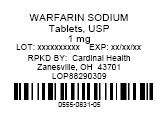
PRINCIPAL DISPLAY PANEL - 1 mg Carton
Warfarin Sodium
Tablets, USP
1 mg
QTY 30
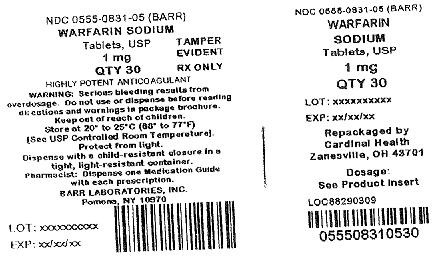
PRINCIPAL DISPLAY PANEL - 2 mg Blister
Warfarin Sodium
Tablets, USP
2 mg
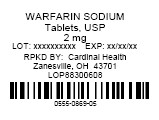
PRINCIPAL DISPLAY PANEL - 2 mg Carton
Warfarin Sodium
Tablets, USP
2 mg
QTY 30
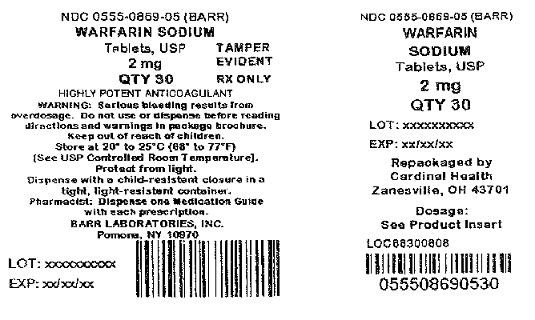
PRINCIPAL DISPLAY PANEL - 2.5 mg Blister
Warfarin Sodium
Tablets, USP
2 1/2 mg
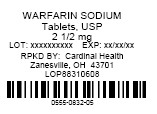
PRINCIPAL DISPLAY PANEL - 2.5 mg Carton
Warfarin Sodium
Tablets, USP
2 1/2 mg
QTY 30
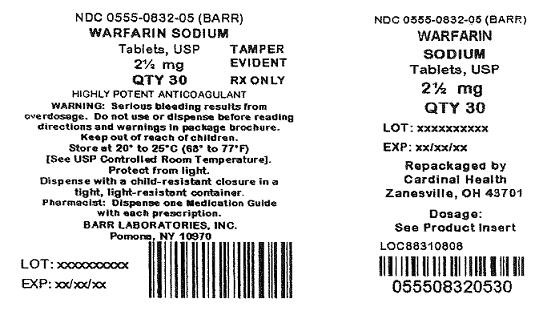
PRINCIPAL DISPLAY PANEL - 3 mg Blister
Warfarin Sodium
Tablets, USP
3 mg
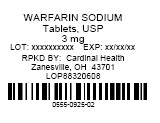
PRINCIPAL DISPLAY PANEL - 3 mg Carton
Warfarin Sodium
Tablets, USP
3 mg
QTY 30
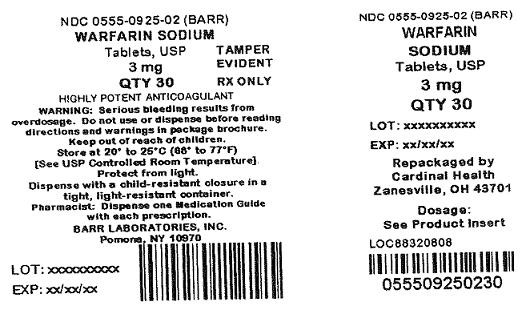
PRINCIPAL DISPLAY PANEL - 4 mg Blister
Warfarin Sodium
Tablets, USP
4 mg

PRINCIPAL DISPLAY PANEL - 4 mg Carton
Warfarin Sodium
Tablets, USP
4 mg
QTY 30
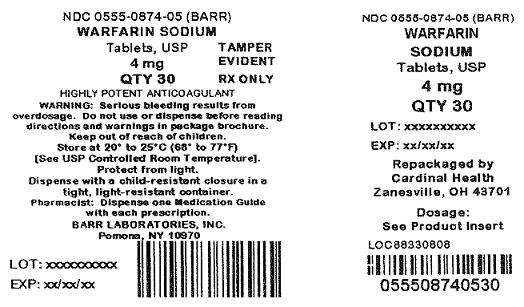
PRINCIPAL DISPLAY PANEL - 5 mg Blister
Warfarin Sodium
Tablets, USP
5 mg
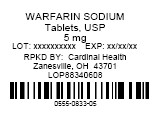
PRINCIPAL DISPLAY PANEL - 5 mg Carton
Warfarin Sodium
Tablets, USP
5 mg
QTY 30
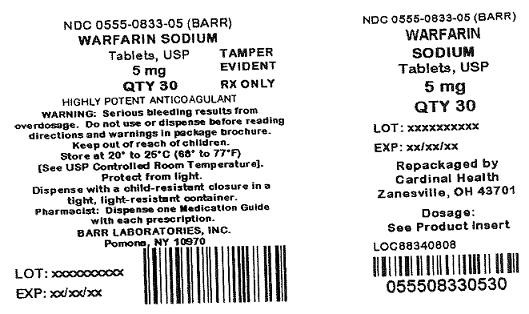
PRINCIPAL DISPLAY PANEL - 6 mg Blister
Warfarin Sodium
Tablets, USP
6 mg
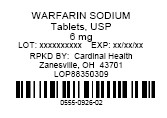
PRINCIPAL DISPLAY PANEL - 6 mg Carton
Warfarin Sodium
Tablets, USP
6 mg
QTY 30
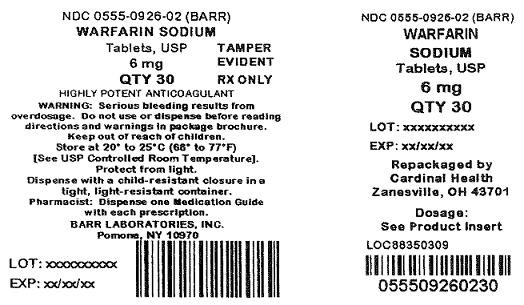
Warfarin SodiumWarfarin Sodium TABLET
| |||||||||||||||||||||||||||||||||||||||||||||||||||||||||||||||||||||||||||||||||
Warfarin SodiumWarfarin Sodium TABLET
| |||||||||||||||||||||||||||||||||||||||||||||||||||||||||||||||||||||||||||||||||||
Warfarin SodiumWarfarin Sodium TABLET
| |||||||||||||||||||||||||||||||||||||||||||||||||||||||||||||||||||||||||||||||||||
Warfarin SodiumWarfarin Sodium TABLET
| |||||||||||||||||||||||||||||||||||||||||||||||||||||||||||||||||||||||||||||||||||||
Warfarin SodiumWarfarin Sodium TABLET
| |||||||||||||||||||||||||||||||||||||||||||||||||||||||||||||||||||||||||||||||||
Warfarin SodiumWarfarin Sodium TABLET
| |||||||||||||||||||||||||||||||||||||||||||||||||||||||||||||||||||||||||||||||||
Warfarin SodiumWarfarin Sodium TABLET
| |||||||||||||||||||||||||||||||||||||||||||||||||||||||||||||||||||||||||||||||||||